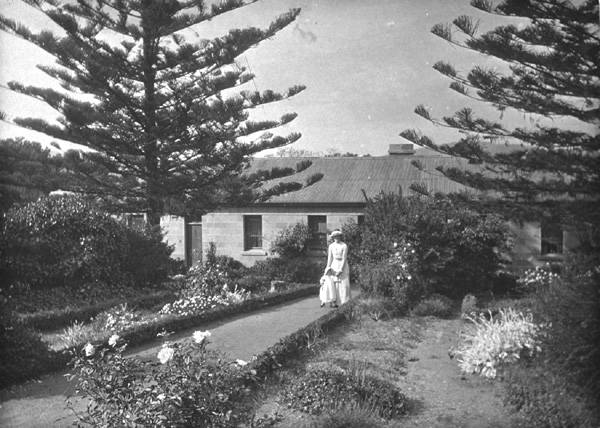 |
 |
|
Astronomy
The first active phase of European astronomy in Tasmania began in 1840 when Sir John Franklin established the Rossbank Observatory in what are now the grounds of Government House. Geomagnetic measurements and weather observations dominated the work of the observatory but it also provided a time service, vital for navigation, by stellar transit observations. After Franklin's departure, government interest declined and Rossbank was closed in 1854. The following year Francis Abbott, a watchmaker and former convict, took over the responsibility for timekeeping and meteorology, continuing on an unofficial and unpaid basis for 25 years. Abbott was one of Australia's leading amateur astronomers. His observatory in Murray Street, Hobart was used to observe comets, transits of Mercury and Venus and the variable star Eta Carinae. A member of the Royal Society of Tasmania and the Royal Astronomical Society of London, Abbott published many papers. His controversial views on the variability of the Eta Carinae nebula were disputed by famous British astronomer Sir John Herschel. Abbott's 'great discovery' was not generally accepted until the advent of astronomical photography a few years after his death. Schoolteacher and accountant, Alfred Biggs of Launceston also made important contributions both as an amateur observer and as a populariser of the science. In 1874 he assisted a visiting American research team which observed the transit of Venus in Campbell Town, in the grounds of The Grange, home of local amateur astronomer Dr William Valentine. Biggs used a 216-mm refractor to observe comets and double stars, and published in local journals and in Monthly Notices of the Royal Astronomical Society. A renaissance in astronomical research was one of the outcomes of the optical munitions research and manufacture during the Second World War, led by physicists Lester McAulay and Donald Cruickshank. During the 1960s Michael Waterworth began development of the Mount Canopus Observatory in the Meehan Ranges, 10 km south-east of Hobart. The observatory's 1-metre optical telescope is used in an international programme searching for extra-solar planets using the microlensing technique and studying the atmospheric structure of giant stars. Other notable achievements include the detection of a dense atmosphere around the planet Pluto, the identification and study of the optical counterparts of X-ray pulsars and transients, and many papers arising out of the microlensing programme. Immediately after the war, McAulay and his student Geoff Fenton initiated research into the nature and origin of cosmic rays. Fenton's team discovered a weak sidereal anisotropy in the cosmic ray stream and published many papers about solar terrestrial interactions. Their research into radiation detector technology led to rocket and balloon-borne experiments to study astronomical X-ray sources. An early success using a Skylark rocket launched from Woomera was the first detection of an X-ray transient – a stellar system containing a black hole or neutron star. A balloon experiment during the Johnston Island hydrogen bomb test in 1961 detected nuclear waste being injected into the radiation belts over Hobart. A 1-metre diameter balloon-borne X-ray telescope, the largest of its kind in the world, was flown several times from Alice Springs and from Brazil. Significant outcomes included the discovery that the X-ray pulsar GX 1+4 had ceased spinning up and evidence for a super-strong magnetic field in this system. In 1986 it was selected as prime candidate payload for the subsequently abandoned Australian 'Mirrabooka' satellite. Tasmania has several advantages for radio astronomy observations. Interference from man-made sources is relatively low and the ionosphere is thinner, allowing lower frequency celestial radiation to reach the earth. This attracted the world's first radio astronomer, Grote Reber, to spend most of his research career in southern Tasmania. In 1955 he and Bill Ellis used a giant wire array at Kempton to measure galactic radio emission at frequencies as low as 0.9 megahertz. In 1960 Ellis was appointed Professor of Physics at the University of Tasmania and built an active research group studying planetary, solar and galactic radio emission using large wire arrays near the Hobart airport. Ellis and his co-workers made an important contribution to our understanding of the low frequency radio emissions from earth's magnetosphere, Jupiter and the Sun. A big step forward came in 1985 with the donation to the University of the NASA 26-metre satellite-tracking telescope at Orroral Valley near Canberra. Two former students of Ellis, Pip Hamilton and Peter McCulloch, rebuilt the telescope and adapted it for astronomy on a new site near Cambridge. In 1995 the University acquired a 30-metre former Telstra antenna at Ceduna, South Australia and modified it for astronomy. These telescopes are used individually and as part of Australian and international VLBI networks studying active galactic nuclei which are believed to contain massive black holes, pulsars and maser emission line sources. They are also used as part of the NASA Geodynamics array to measure the rate of continental drift. A 14-metre dish at the Cambridge site is dedicated to observations of the Vela pulsar and has detected several sudden changes in the pulsar period. These measurements are critical for our understanding of neutron star physics. Further reading: R Haynes et al, Explorers of the southern sky, New York, 1996; W Orchiston, 'The contribution of Francis Abbott to Tasmanian and Australian astronomy', Vistas in Astronomy 35, 1992; and 'The role of the amateur in popularizing astronomy: an Australian case study', Australian Journal of Astronomy 7, 1997. John Greenhill
|
Copyright 2006, Centre for Tasmanian Historical Studies |
